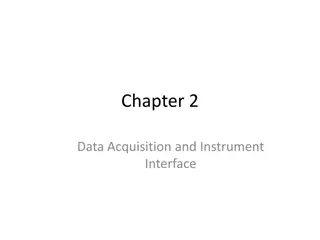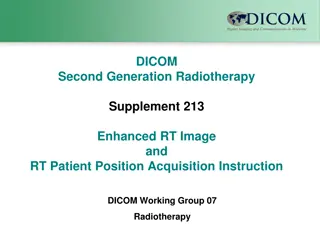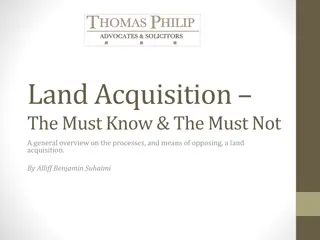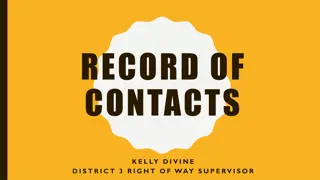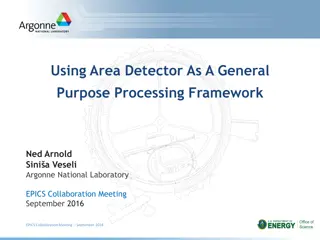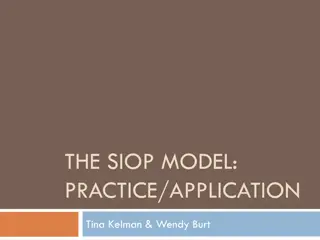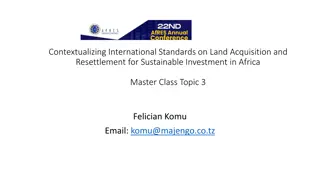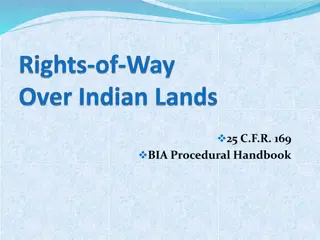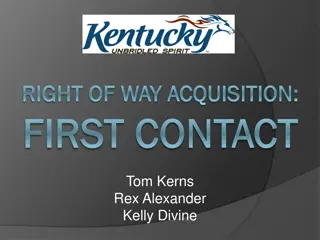Steps in Right of Way Acquisition Process
The steps involved in making the first contact on a right of way acquisition begin with sending notices to property owners, verifying environmental impacts, setting up the project, researching comparable sales, checking legal descriptions, and preparing necessary forms. The Acquisition Agent plays a key role by ensuring accuracy throughout the process.
Uploaded on Sep 24, 2024 | 1 Views
Download Presentation

Please find below an Image/Link to download the presentation.
The content on the website is provided AS IS for your information and personal use only. It may not be sold, licensed, or shared on other websites without obtaining consent from the author.If you encounter any issues during the download, it is possible that the publisher has removed the file from their server.
You are allowed to download the files provided on this website for personal or commercial use, subject to the condition that they are used lawfully. All files are the property of their respective owners.
The content on the website is provided AS IS for your information and personal use only. It may not be sold, licensed, or shared on other websites without obtaining consent from the author.
E N D
Presentation Transcript
RIGHT OF WAY ACQUISITION: RIGHT OF WAY ACQUISITION: FIRST CONTACT FIRST CONTACT Tom Kerns Rex Alexander Kelly Divine
THE STEPS INVOLVED IN THE STEPS INVOLVED IN MAKING THE FIRST MAKING THE FIRST CONTACT ON A RIGHT OF CONTACT ON A RIGHT OF WAY ACQUISITION WAY ACQUISITION BEGINNING WITH THE INITIAL OFFER TO THE CLOSING PROCESS
The Right of Way Supervisor sends the Notice of Acquisition letter to all affected property owners through certified mail. The Right of Way Supervisor verifies with the District Environmental Coordinator if any historical land or buildings are being affected. If so, appropriate measures are taken to identify that parcel on the plans and minimize the impact.
The Right of Way Supervisor or Project Manager will set up the project and make assignments in the RWUMS system. Each assigned agent should view the project (prior to making any offers) to become familiar with the area and to take photos of the designated MAR parcels, if applicable. It is recommended that photos from several directions of the acquired areas be taken.
Research both the county PVA office and the assigned appraiser s sales book, if applicable, for the most recent comparable sales in which to base your approved Range of Values and MAR calculation. At this time, it is also recommended to secure site improvement costs (such as trees, fencing, gravel, etc.) from the assigned appraiser or local contractors for your MAR calculation, if applicable.
The Acquisition Agent checks the legal description(s) and areas being acquired against the right of way plans, the right of way summary sheet, and appraisal (if applicable) for accuracy purposes. The agent should verify the most recent legal descriptions and right of way plans with the Design Project Manager. A color-coded copy of the plan sheet(s) should be created by the agent and provided to the property owner(s) at the Offer to Purchase meeting.
Prepare initial forms Deed of Conveyance or Grant of Easement, Memorandum of Understanding, Offer to Purchase form, and Offer to Purchase Letter, if applicable. Once the Deed or Grant of Easement is prepared, it should be reviewed by the attorney, who will be signing the document, for his/her approval. Print cross sections, note the cuts/fills, ditch depths and distances from the shoulder, etc.
Read and study the approved appraisal if applicable (especially Sheet 10) as well as the right of way plans. Anticipate property owner questions and concerns. Know the acquisition dimensions and distances from primary structure(s), salvage values (if applicable), proposed elevations, control of access, scheduled clearance date, letting date, etc. Talk with the Design Project Manager to get a brief history of the project (history, purpose, location, etc.). Extensive knowledge of the project and parcel will establish the agent s credibility and confidence.
Contact the property owner and schedule the appointment at his/her convenience. If possible, make the initial meeting in person. If relocation is involved, coordinate the appointment with the assigned Relocation Agent as well. Arrive at the appointment on time to make a good first impression with the owner. At the initial meeting, the Acquisition Agent should bring the prepared Deed of Conveyance or Grant of Easement, the prepared Memorandum of Understanding, a copy of the approved appraisal or MAR calculation, colored plan sheets, offer to purchase letter, Right of Way booklet, and scale.
Verify the title facts with the property owner and explain the proposed acquisition. If there are any existing liens against the subject parcel, it needs to be explained that a full or partial release will be required from the lending institution. Review the 21-question ROC checklist with the property owner. Offer to view the proposed acquisition with him/her. Provide the Offer to Purchase both verbally and in writing. Attempt to answer all property owner questions/concerns to the best of your ability. Any unanswered questions or concerns should be documented and taken to the appropriate individual(s). Answers to the owner s concerns need to be provided in a timely manner. Leave a copy of the approved appraisal or MAR calculation with the property owner, along with a copy of the colored plans and Right of Way booklet.
Document the initial contact and all subsequent contacts in the RWUMS system as soon as possible for accuracy purposes. Be sure to include all pertinent information discussed, such as improvements acquired, entrances (size/grade/location), elevations, proximity of the acquisition to the primary structure(s), etc. During the course of negotiations, it is also important to document all unsuccessful attempts to reach a property owner: cite the date and time of all phone calls or visits in one ROC entry to minimize contact sheets.
Answer all property owner questions/concerns (document both within ROC) and work toward having a final decision made within 30 to 45 days of the FMV offer. If possible, attempt to schedule at least 3 face-to-face meetings with the property owner. This creates trust and a rapport as well as minimizes miscommunication and misunderstandings. If an agreement is reached, have the property owner execute the Deed of Conveyance or Grant of Easement and Memorandum of Understanding. Explain the 6 to 10 week time frame to secure the FMV check and conduct the closing (longer if a state employee). Make sure to include any concession made within the Record of Contacts and Page 2 of the MOU. If encumbrances exist, it needs to be explained further delays may be incurred and the owner s assistance may be needed to secure the necessary releases. Finally, explain the pro rata taxes if fee simple is acquired. If it is a total acquisition, the pro rata taxes need to be determined and deducted from the check amount.
The Acquisition Agent then prepares a parcel batch for review and approval by the Right of Way Supervisor/Project Manager, which includes the following (see attachment). Once approved, the parcel batch is submitted electronically to Central Office for approval and processing. If an agreement is not reached, the Acquisition Agent sends the property owner a 10-day letter through certified mail notifying them that subject parcel will be submitted for condemnation if a reasonable/justifiable counter offer is not received. If the parcel is submitted for condemnation, the district office electronically sends the following to central office: see attachment. This will then be forwarded to the Office of Legal Services for attorney assignment.
Conduct the closing at the property owners convenience once a title update has been conducted to ensure no new encumbrances or property transfers have occurred. Secure all necessary releases. Have the property owner sign an acknowledgement that he/she received the FMV check. Provide them with a letter reminding them of the tax reimbursement eligibility, if applicable. Record the Deed/Grant of Easement and Releases on that same day, if possible. For consultants, this will require coordination with the assigned attorney who will be signing the deed as preparer.


